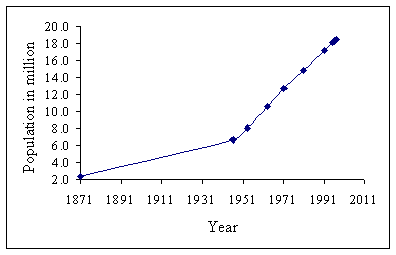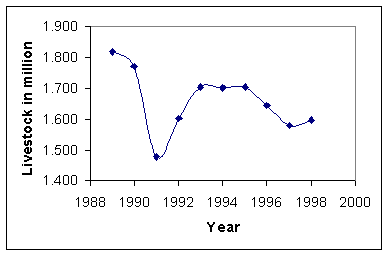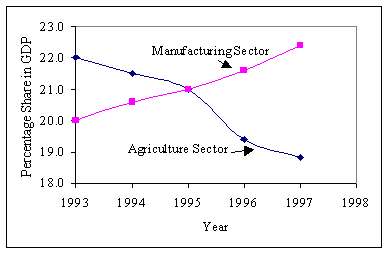


Various contextual factors affect dynamics of forest resources in a complex manner and in turn also get affected by it. This chapter attempts to provide an indication of the dynamics of some such contextual factors like population, agriculture, livestock, and economic growth in Sri Lanka.
Natural forests of Sri Lanka face direct pressure from human population, agriculture and livestock and induced pressure from rapid economic development. The four principal crops (tea, rubber coconut and rice) continue to maintain their traditional dominance in Sri Lankan farm portfolio. The rice is consumed domestically while most of the tea, rubber, and coconut are exported to other countries. The area under agriculture is increasing. Although, the importance of other crops has increased over time but none has been able to challenge any of these traditional "four" crops. The human and livestock population continue to rise and exert increasing pressure on shrinking forest resources though at reduced rates. However, fast improvement in development of human resources show a positive sign in Sri Lanka and are contributing towards creation of conditions that in the longrun are conducive for the sustenance of natural resources.
The human population of Sri Lanka has grown from 2.4 million in 1946 to 18.5 million in 1997 (Fig. 4). Table 30 at Annex provides districtwise distribution of this population. The majority (66%) of the population is in the age group of 15-64 years. The females have higher life expectancy (75 years) than males (70 years). The decline in infant mortality and increase in the life expectancy (about 72 years) is also contributing towards increase in the population (Figure 4) though at reduced rates (Figure 5).

Fig. 4. Increase in human population
During last decade, the population has grown at 1.2%, slower (Figure 5) by about 0.3% than previous decade (1981-91). The increasing share of females and aged in the total population and the labor force is creating new and complex gender and unemployment issues. However, the government is very optimistic about decline in population growth rates and predicts a steady state (zero growth rate) in labor force from 2010 onwards.

Fig. 5. Trend in annual growth rate of human population
The colonial administration sold large tracts of land to private persons and companies for developing coffee and tea plantations to augment their revenue generation from exports. The precise impact of the plantations on village society remains controversial, but it is widely believed in Sri Lanka that the standard of living of villagers has suffered when they lost forest lands.
From 1930s the focus of agricultural development shifted from the wet zone to the dry zone and from plantation crops to rice as it became clear that very little additional cultivable land is available in the wet zone. The Mahaweli Program in 1980s has accelerated this approach and promoted cultivation in the dry zone. The most important change in agriculture after independence of Sri Lanka has been an increase in the production of rice due to increase in the productivity and the diversion of additional land for rice cultivation.
The principal export crops (Tea and Rubber) show modest gains in productivity even when the productivity of tea crops with small holders is increasing (AR, 1997). The declining profitability in coconut cultivation coupled with increasing demand of land by industries, housing and other development programs is leading to fragmentation of areas under coconut cultivation. Rubber plantations are facing similar pressures.
Sri Lankan farming households maintain livestock for draft power and source of cash income (goats and poultry) with women looking after them. It is an integral part of the farming system. The livestock population has increased since 1996 (Figure 6, and Table 31). If this trend continues for quite some time then it may pose sustainability problem for forest resources.

Fig. 6. Livestock population
Due to government commitment for good health, many of Sri Lanka's social indicators compare favorably with advanced countries. Infant mortality rates have fallen from 48 per 1,000 live births in 1970 to 16 per 1,000 in 1996, maternal mortality rate has dropped from 90 per 100,000 live births in 1980 to 30 in 1996, and birth rates have declined from 4 births per woman to a near replacement level of 2.4 births per woman.
The national unemployment rate is declining due to additional employment provided by the private sector but the real wages are deteriorating in almost all sectors. The manufacturing sector continues to register increase in labor absorption (15 % in 1996 to 16 % in 1997) and in the share of female workers. However, wide disparities exist in socio-economic status and access to employment opportunities.
Sri Lanka, therefore, has better conditions to sustain natural resources than other South Asian countries due to its higher level of human development as indicated by improving health, higher literacy, better education and lower unemployment rates. Sri Lanka has achieved highest level of literacy rates (92 percent) among South Asian countries (Table 32 at Annex). About 56 percent of its population has attained the secondary and higher level of education. 5.6 Economic growth and development
In 1977, Sri Lanka made major transformation to move from an inward-looking socialist system to a market economy based system with deregulated foreign investment regime. Since then, the gross domestic product (GDP) has grown at a moderate rate of 4-5 percent a year. This performance, however, has been well below the country's potential, due in part to slow implementation of fiscal reforms, particularly in the public sector, agriculture, and banking.
Sri Lankan economy is growing at about 6.4 percent (1997) and main industries are engaged in processing of rubber, tea, coconuts, other agricultural commodities, clothing, cement, petroleum refining, textiles, and tobacco. The per capita income (US$814 in 1997) in Sri Lanka is approaching the level of middle income countries. The growth of exports is higher than that of imports.
The recent macro-economic improvements in Sri Lankan economy are contributing to stability of domestic financial markets and equitable income distribution but the economic growth has not been sufficiently broad-based to absorb under- and unemployed labor throughout the country and the performance is fragile due to slow progress towards its social and political stability.
The current economic growth is inducing pressures on forest and other natural resources through increased demand and consumption of forest product and services. There is a general resistance for including environmental considerations into every aspect of development planning. Such pressures are adversely affecting the sustenance of forest and other natural resources in Sri Lanka.
The manufacturing sector provides the highest support to the economic growth of Sri Lanka. The mining sector makes the least contribution (about one percent) to the growth of national economy (Table 33 at Annex). The share of agriculture sector including forestry is consistently declining and that of manufacturing sector is consistently increasing (Figure 7).

Fig. 7. Trend of share of different sectors in GDP
The forestry and livestock sub-sectors under "agriculture" sector are continually losing (Figure 8) their ability to define the growth rate of "agriculture" sector in Sri Lanka (Table 34 at Annex) because the relative contribution to GDP from other sub-sectors of "agriculture" like fisheries, tea and other agricultural crops is increasing (Table 35 at Annex). Therefore, the capacity of other factors, that affect sub-sectors other than forests like variation in tea prices, efficiency of management of tea estates, impact of natural calamities and weather on paddy, increased access to potential fishing areas, and growth of inland fishing, is increasing in defining growth rate of agriculture and the economy as a whole.
Fig. 8. Percent share of Forestry and Livestock in GDP of Agriculture Sector
The current estimate of contribution of forestry sector in the national economy is about four times more than what is reflected in the national accounts of Sri Lanka (FSMP, 1995). The current national accounting system does not include the contribution of "Non Marketed Goods and Services" from forests and under estimates the contribution of wood to national economy by about 10 percent. Further, the current national account do not appreciate that the forest sector supplies more than 44 percent of the total energy in Sri Lanka (FSMP, 1995).
The national accounts indicate that the contribution of agriculture sector including forestry to the labor absorption is continually declining for example from 38 percent in 1996 to 35 percent in 1997. However, special studies done for FSMP (1995) reveal that the total employment in the forestry sector alone is around 330,000 that is almost double of the official figure of 171,000.
The tree resources in Sri Lanka are under typical South Asian conditions. While, on one hand, high unemployment, increasing population, expanding agriculture, rapid economic growth and low capacity of law enforcement are mounting adverse pressure on tree resources, on the other hand, high levels of literacy, education and health are favoring better conservation measures both in short and long term.